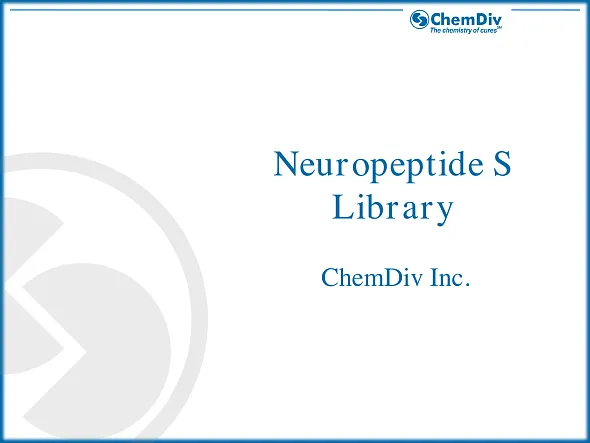Neuropeptide S Library
ChemDiv’s library of neuropeptide S targeted small molecule compounds comprises 3,000 entries.
Neuropeptide S (NPS) is a 20-residue peptide that acts as the endogenous ligand of the Neuropeptide S Receptor (NPSR), a formerly orphan G-protein-coupled receptor (GPCR), which activation leads to increasing calcium and cyclic adenosine monophosphate (cAMP) levels. The NPS/NPSR system, expressed in various brain regions, regulates critical biological functions, including locomotor activity, arousal and sleep, anxiety, food intake, memory, pain, and drug addiction.
The medicinal chemistry and pharmacology of both peptide and non-peptide NPSR modulators, as potential drug discovery targets, have been extensively investigated. Several potent NPSR antagonists serving as pharmacological agents are available, though they exhibit suboptimal pharmacokinetic properties in vivo. Optimization of these ligands is crucial for accelerating their potential clinical application as pharmaceuticals for treating drug addiction. Small-molecule NPSR agonists facilitate the exploration of the beneficial effects of selective NPSR activation across a range of psychiatric disorders, highlighting their therapeutic potential as anxiolytics, nootropics, and analgesics [1].
All chemotypes presented in the reference library have been studied for common motifs. Fragments crucial for high potency have been predicted based on review of literature and expert opinion. The library core is made of hydrophobic or aromatic fragments and hydrogen bond acceptors (HBAs).
NPSR modulators play a significant role in drug discovery, particularly for the neuropsychiatric and neurological disorders. As NPSR is involved in regulating various crucial brain functions, modulators of this receptor offer potential therapeutic avenues for a wide array of conditions. Agonists of NPSR could be beneficial in enhancing cognitive functions and alleviating anxiety, making them potential candidates for treating disorders like anxiety, depression, and cognitive impairments. Conversely, antagonists of NPSR might be useful in managing conditions such as insomnia or drug addiction by dampening the receptor's activity. The ability to modulate the NPS/NPSR system opens up possibilities for developing novel treatments for psychiatric and neurological diseases, where current therapeutic options are often limited or come with significant side effects. Thus, NPSR modulators are a focal point in the search for new, more effective drugs in mental health and neurology.
References
[1] C. Ruzza et al., Neuropeptide S receptor ligands: a patent review (2005-2016), vol. 27, no. 3. Taylor & Francis, 2017.
